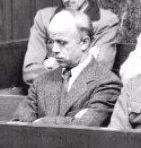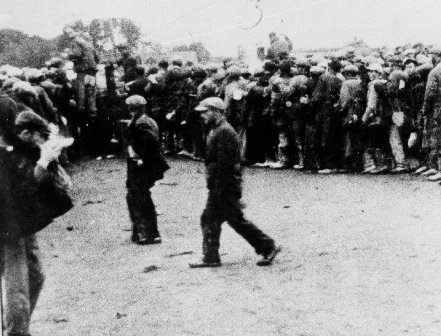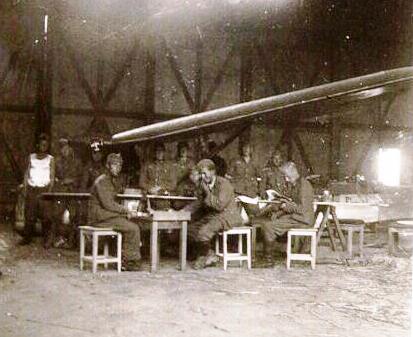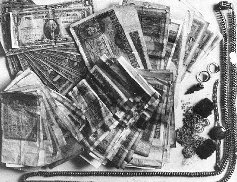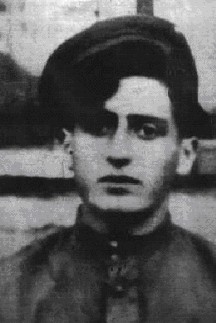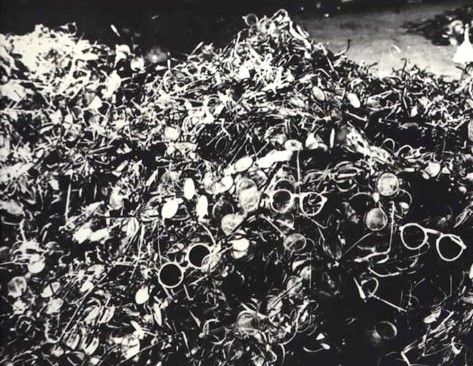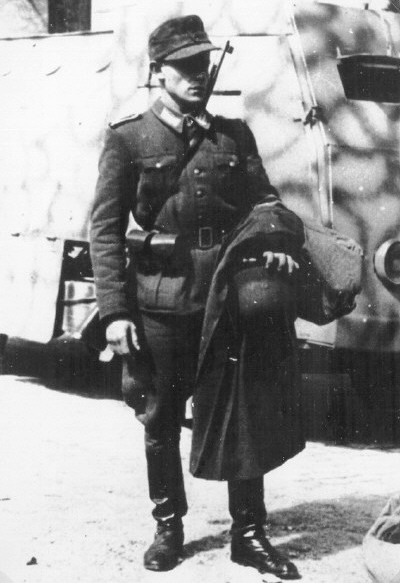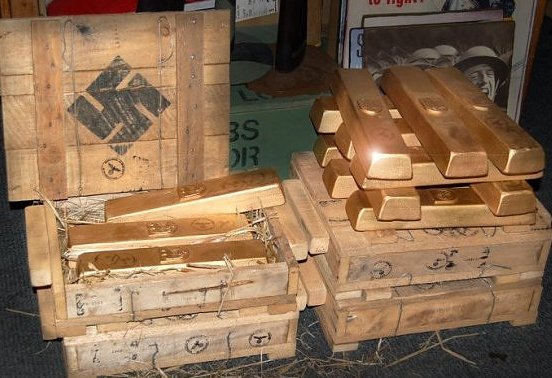Holocaust Education & Archive Research Team |
|
Holocaust Economics
| |||||
Aktion Reinhard Profiting from the Holocaust
SS- Brigadefuhrer August Frank, one of the heads of the Economic and Administrative Main Office (WVHA) issued an order on the 26 September 1942 to the Aktion Reinhard headquarters in Lublin and to the commandant in Auschwitz, regarding the correct procedure for the treatment and distribution of Jewish possessions and valuables within the extermination camps.
Within the three death camps, Belzec, Sobibor and Treblinka the Germans established working commandos to sort and pack the possessions of the murdered Jews to the Reich, in accordance with August Frank’s orders.
Heinrich Unverhau who supervised the storage depot in the locomotive sheds at Belzec testified at his trial:
“SS Sturmbannfuhrer Hering accused me of being a saboteur because of the fact that during the sorting of the clothes that were sent for utilisation in Germany, a yellow Jewish star was found. Some money was also found there. These clothes belonged to Jews who were killed in Belzec.”
Oskar Deigelmann a Reichsbahn official recalled a visit to Belzec:
“As a controller I was responsible for ensuring the track was in good condition and in particular that the train ran smoothly. During a visit to the station at Belzec the supervisor, a Secretary or Senior Secretary from Thuringen, informed me that he was having a lot of problems with the SS, who were stationed near the wood.
Some time later I myself saw and had a word with a number of SS people in the waiting –room at Belzec. When I inquired, they told me that they were not members of the SS but they had merely been given these uniforms. As they described it, most of them came from lunatic asylums or nursing homes in the Reich, where they had been involved in the killing of the mentally ill.
I would like to say that one day the full significance of Belzec camp became clear to me when I saw mountains of clothes of all types behind our locomotive shed. There was also a large number of shoes there, as well as jewellery and other valuables.
The SS had piled these things up there. Petrol was poured over items of clothing that were no longer wearable and they were then burnt. There were a lot of rumours that valuable items were trafficked by the camp staff in the surrounding area. So it was not surprising that women of easy virtue, in particular, were attracted to the area surrounding Belzec, where they set themselves up in business. There were apparently a lot of orgies at that time.”
At the Sobibor railway station just outside the death camp railway worker Jan Piwonski testified:
“I saw how the goods which were of no value to the Germans were burned. The other goods were loaded on freight cars and sent to Germany. Such transports with objects and clothing departed twice a month.
Valuables, gold, and money were packed in an iron box and sent to Berlin twice a week. I myself saw these boxes. The guards (Ukrainians) said that inside those boxes, were gold, money and valuables.”
Ernst Gollack an SS Rottenfuhrer who worked at the Bekliedungswerke at the Old Lublin airfield from January 1942 testified:
“From May or June 1942, in the clothing camp of Lublin, furs and coats of Jews who were in the extermination camps of Belzec, Treblinka and Sobibor were disinfected and sent to Germany. These articles were brought by freight trains, unloaded by the Ukrainian auxiliaries and later by the working Jews, disinfected and loaded again in the freight cars. I was in charge of a group of twenty to thirty Jewish women who were trained as disinfectors.
The clothing was divided according to men’s, women’s and children’s clothing. Then it was subdivided again: outer and under clothing, shoes etc. Where these sorted clothes were sent I don’t know exactly. I once saw on the freight cars the names of the train stations: Berlin, Glogau, Breslau and Hirschberg.”
SS- Unterscharfuhrer Gustav Munzberger testified after the war:
“I know that Matthes – who was in charge of Camp II at the end of each day when a transport arrived, used to take the gold to the Lower Camp. This relates to gold teeth and valuables of gold that had been found on the corpses. This gold was brought in a small case.”
The Ukrainian guards acquired large amounts of Jewish gold and valuables and they spent it in the vicinity of the three death camps, and Jerzy Krolikowski a Polish engineer who worked near the Treblinka death camp related:
“The events that I have described – the extermination of the Jews in Treblinka – caused a real revolution in the vicinity of Treblinka. The poor areas of Podlassia overflowed with gold, and riffraff from all over the country came there to get rich quickly and easily.
Even among the local population there was, unfortunately, a certain group that wanted to make a fortune from the Jewish tragedy at any cost. It was our luck that as far as I know the workers in our construction company were not tempted to go along with this.
I scorned the frequent offers I was made to buy watches, gold coins and various articles for almost nothing. The Ukrainian fascists who were on the staff of the death camp were the ones, who brought the gold coins, valuables and money from the camp.
At first they were not aware of the real value of the articles, and one could buy all kinds of things for next to nothing. Men’s watches were sold literally for pennies, and local farmers kept dozens of them in egg baskets to offer them for sale. The Ukrainian fascists, who were totally corrupted by the wealth they had acquired with no effort, were contemptuous of its worth. For example, they would pay for a drink without even counting the bills.
The avarice that was rampant among a certain section of the local population destroyed all moral foundations. In the neighbouring villages near the camp the Ukrainian fascists were welcomed by some of the local farmers. Their daughters, as it was widely known, became the girlfriends of the murderers and enjoyed the benefits of their generous hearts.
It is no wonder that, even though it was wartime, one could see in the neighbouring villages extensive construction on the farms and the village women wearing furs and clothes of expensive material whose source was well known.”
Rudolf Reder described what happened to the gold and valuables in the Belzec death camp:
“On the way from the gas chambers to the graves, and thus along several hundred metres, stood several dentists with pincers. They stopped each of the workers dragging corpses, opened the mouth of the cadaver, looked into it and pulled out the gold, and threw it into a basket. There were eight dentists.
Most of them were young, picked out of transports to perform this work. I got to know one of them better. His name was Zucker, and he came from Rzeszow. The dentists had their own little barracks, together with the doctor and the pharmacist.
At sundown they carried the baskets full of gold teeth to their barracks, where they separated the gold out and melted it down into bars. A Gestapo officer, Schmidt, guarded them and beat them when the work went too slow. Each transport had to be done in two hours. The teeth were melted into bars one centimetre thick, half a centimetre wide, and twenty centimetres long.
Philip Bialowitz who was deported from Izbica to Sobibor explained what happened to new arrivals, and their possessions:
“Everyone would go to large rooms where they left all of their personal belongings and if they became suspicious of anything, they were beaten. Then prisoners including Bialowitz would go through their belongings to obtain valuables for the Nazis.
The Germans would then apologise for not letting the people relax and would tell them to go shower to be disinfected, and to write postcards home telling their family about the place, people then got undressed, we took their watches and jewellery, but they still had no idea that the showers were gas chambers.”
Samuel Willenberg who was deported to Treblinka death camp and he described the role of the Goldjuden in the camp:
“The prisoners responsible for collecting and sorting the gold, jewellery, money and other valuables which had reached the transport yard were known as Goldjuden (gold Jews) and wore yellow shoulder bands to distinguish them.
At any one time several of them would wander about the sorting –yard collecting any valuables we had found in the clothing. Goldjuden were considered the elite of the prisoners. Their work was relatively tranquil: they sat in a closed warm hut under the supervision of Suchomel, a German from the Sudetenland who spoke good Czech and usually assigned this work to Czech Jews sent to Treblinka from Theresienstadt. “
Georg Wippern statement to the Court, after the Second World War, confirmed his role in the economic plunder of Jewish valuables:
“In this context I want to mention that in the beginning I had nothing to do with jewellery and valuables. But then I was asked to come to Pohl in Berlin, who from then on put me in charge for the registration and delivery of valuables and jewellery. On this occasion I learned they that they were Jewish property. Because of that I wanted to refuse handling this task, but finally in a fierce battle of words was referred by Pohl to the Bruning Emergency decree from the year 1932.
According to the Heinrich Bruning Emergency Decree where there was given an order that non-registered foreign currency and precious metal were due for confiscation. Enforcement of this law was an obligation of the Reich’s finance authorities.
At this meeting I heard for the first time the name Wirth. Because Wirth initially delivered the confiscated jewellery and valuables in a disorderly condition at the Reichsbank in Berlin, now this work should be done by me, nothing but as a purely administration specialist
In this context I refer to the statements which I made at the Public Prosecutors Office in Hamburg. According to this, Wirth was obliged to deliver the valuables to me. This way I came to know Wirth. I want to emphasise that those jewels and valuables delivered to me not only came from the extermination camps but also from SS and Police Leaders in Warsaw and other places.”
Couriers from T4 came from Berlin regularly to Wirth’s headquarters and Wippern’s office to collect money and valuables that came to Lublin from the death camps. Erich Bauer who served at Sobibor as the gas-meister visited Wirth at his office on Chelmska Street recalled the procedure:
“During the whole time of the Jewish operation in the camps, the T4 couriers took with them two chests. The chests, to my knowledge, were continuously transported between Berlin and the camps.”
The regular couriers Erich Fettke and Philip Post both carried special passes signed by Heinrich Himmler RFSS, forbidding the opening of any luggage carried by the couriers, but Fettke reported that twice near Lublin the chests were seized by SS-men.
Another courier who made infrequent journeys was Josef Kolbl from T4 who recalled thus in 1962:
“I travelled to Lublin three or four times as a courier and called at the office of Sturmbannfuhrer Wirth. My job consisted of taking locked chests to Lublin and bringing back another locked chest. I can say for certain that I handed over the chests to Wirth, and then on the return journey took a chest from him.”
SS- Oberscharfuhrer Johannes Teichelmann, a member of Wippern’s staff was quartered in wooden barracks in the courtyard of the SS- Standortverwaltung testified:
“At the Standortverwaltung in Lublin I was employed in the ranks of Aktion Reinhard. My immediate superior was SS-Sturmbannfuhrer Wippern. I had to supervise a small group of about 30 Jews who had the job of sorting gold and other valuables. This Jewish work-brigade also handled foreign currency.”
Johannes Teichelmann also admitted he brought chests of valuables from the death camp at Treblinka by lorry on two or three occasions. Because of the stench of rotting corpses, he realised that Jews were being killed there.
Two smelting furnaces were installed in the courtyard of the SS-Verwaltungsamt, and the gold and silver were smelted into ingots and the foreign currency was first sent to the SS-WVHA in Berlin and then forwarded to the Reichsbank.
Polish currency was paid into a bank account in Lublin by Wippen’s staff for eventual transfer to the Reichsbank in Berlin. How much money and valuables were kept by the members of Aktion Reinhard will never be known, but Odilo Globocnik presented to Himmler in late 1943, a detailed account of the Aktion Reinhard balance sheet which is covered [here]
Note: VoMi stands for Volksdeutsche Mittlestelle. German Racial Assistance Office founded in 1936 and headed by Werner Lorenz
Sources: Belzec, Sobibor, Treblinka by Yitzhak Arad, published by Indiana University Press, Bloomington and Indianapolis 1987. Those Were the Days by Ernst Klee, Willi Dressen, Volker Riess, published by Hamish Hamilton London 1988. Belzec by Rudolf Reder, published by Panstwowe Muzeum Oswiecim- Brzezinka 1999. Surviving Treblinka by Samuel Willenberg, published by Basil Blackwell 1989 Interview with Philip Bialowitz on the 15 August 2008 – Jewish State Odilo Globocnik – Hitler’s Man in the East by Joseph Poprzeczny, published by McFarland & Company 2004 Christian Wirth: Inspekteur Der SS-Sonderkommando Akrion Reinhard by Michael Tregenza 1995 – Holocaust Historical Society
Copyright Victor Smart & Chris Webb H.E.A.R.T 2009
|
